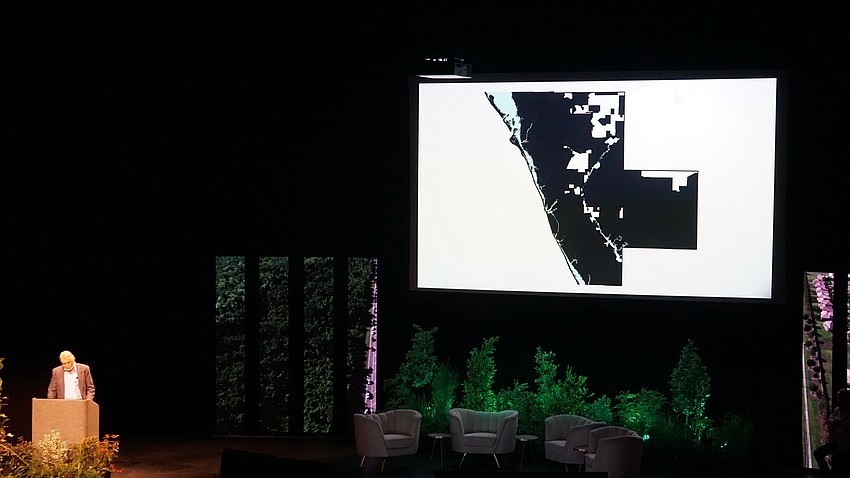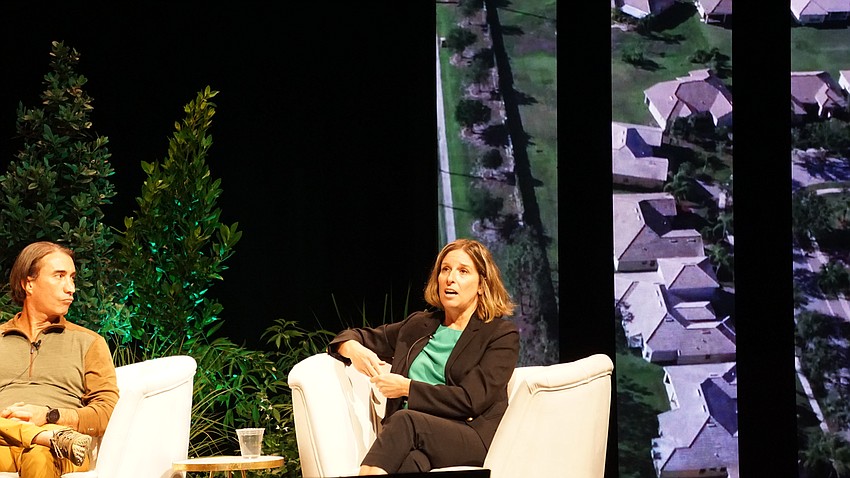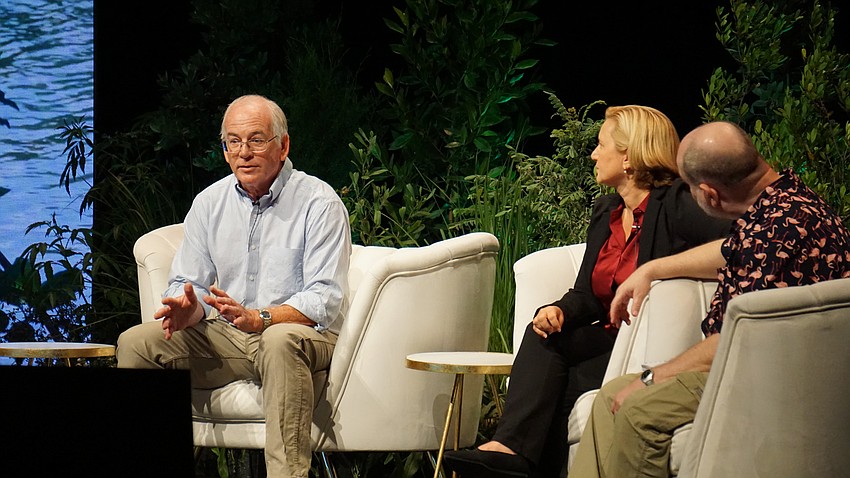- October 23, 2024
-
-
Loading

Loading
When it comes to environmental issues, it’s all about challenges and opportunities.
That was a recurring theme throughout the three-day EcoSummit hosted in Sarasota at the Van Wezel Performing Arts Hall from Dec. 4-6.
The event was hosted by the Science & Environmental Council of southwest Florida. The nonprofit serves the community by hosting similar events and sharing knowledge related to the environment.
On the first day, keynote speaker and documentary filmmaker Damon Gameau talked about seeking new environmental stories. Later that night, writer Carl Hiaasen, “Florida’s most savagely funny, riotous and cathartic storyteller” shared some of his Florida stories from dolphin-tourist relationships to alligator encounters.
Six sessions took place during the three-day event, which included panel discussions, case studies and storytelling from over 50 speakers.
Here is a snapshot.
“(Sarasota 2050) was the worst vote, the worst decision, in my 20 years as a county commissioner.” –Jon Thaxton, director of community Iivestment for Gulf Coast Community Foundation
Former Sarasota County Commissioner Jon Thaxton now works for the Gulf Coast Community Foundation as the director of community investment.
After the first keynote speaker of the event, Thaxton shared his view on Sarasota’s story of growth, blending a bit of history with messages for the future.
Before the 1920s, Thaxton said this area functioned as a “united ecosystem,” when beaches were still wild and uninhabited areas were abundant.
By the 1970s, Sarasota County’s population had grown to 120,000 people. The growth and development continued as a “three-front assault” on Sarasota County’s rural character, according to Thaxton. The county’s population was around 434,000 people in 2020.
Moving through the years, Thaxton reached present day, and Sarasota County’s current land-use plan, which he said is governed largely by the Sarasota County 2050 plan.
“The plan was built as the grand bargain by rural preservationists, environmentalists, developers and landowners,” Thaxton said.

According to Thaxton, the promise was new-urbanist, walkable and self-sufficient communities while leaving much of the remaining rural land undeveloped.
“The policies have been slowly and slowly eroding away,” Thaxton said.
Thaxton presented a map of the county’s adopted comprehensive plan simplified into two categories: everything built or planned to be built, and the area remaining where usage has yet to be determined.
Only 34,000 acres of land for which usage has yet to be determined remain. That’s about 10% of the county’s acreage, he said.
Thaxton advised the audience that history informs the future but does not define it.
“The focus of the Eco Summit 2023 is all about how we can do better,” Thaxton said. “We have the local knowledge and ability to distinguish ourselves once again as an environmental leader in the state of Florida. And it all starts with you.”
“Local governments have to really create their vision, there has to be community buy-in.” –Evangeline Linkous, associate professor at University of South Florida
Following Thaxton’s talk was a panel discussion about growth and balance, moderated by Paul Owens, president of 1000 Friends of Florida.
For the discussion, Owens was joined by Associate Professor at University of South Florida Evangeline Linkous, Spinnaker Group Sustainability Advisor Juliette Desfeux and President of Cherry Lake Tree Farm Timothee Sallin.
One of the main themes of the discussion was that smart, local planning is a key to breaking out of current trends as described by Thaxton.
Nearly 8 acres of open land is lost per hour in Florida to development, Owens said. The impacts of a booming population and increased development are already being seen.
“Who wants to live in a place that is notorious for traffic jams and blue-green algae?” Owens said.
One of the most effective ways to preserve natural land in the state, according to Owens, is public acquisition and support for the agricultural economy.
“When we commit to preserving public land, we discourage sprawl and all of its negative impacts, and we encourage more responsible urban infill and redevelopment,” Owens said.
Sallin’s main points focused on supporting the rural agriculture of the state and promoting ecological sustainability.

Aside from acquisition, though, Linkous said it’s important that local governments take charge in creating more sustainable development practices. This starts with local comprehensive plans and land development regulations that can allow for a community to create a sustainable vision.
“The challenge is moving forward, it’s communicating these views at the local and particularly the state,” Owens said. “Hopefully by doing the things I mentioned, by showing up and speaking up, we can help turn the tide on this.”
I don’t want us to lose Sarasota Bay. I want it to be a recovered system." –Dave Tomasko, director of Sarasota Bay Estuary Program
The second day began with a panel discussion moderated by journalist Craig Pittman, during the session called “Billion Dollar Bays.”
In the panel was Director of the Sarasota Bay Estuary Program Dave Tomasko, Director of the Tampa Bay Estuary Program Ed Sherwood and Director of Coastal & Heartland National Estuary Partnership Jennifer Hecker.
The directors began talking about some of the differences between their respective estuaries, but all shared some similarities. All focus on place-based problems specific to their estuaries, and money received for their programs comes largely from the Bipartisan Infrastructure Law.
All three talked about tackling issues of estuary health and sea level rise. Sherwood referenced the Piney Point leak of 2021, and how Tampa Bay is still in a seagrass deficit, though water quality has been improving.

Tomasko said impacts of sea level rise are already being seen. A prime example is the flooding that happens in the Longboat Key Village during high tides or rain events, he said.
The three panelists were asked why preserving the health of estuaries is important. Economic value, jobs, tourism and quality of life, they all said.
“Florida is going to look totally different over the next 10-20 years,” Sherwood said. “And we need a vision that keeps these habitats front and center.”
Collaboration is key, Tomasko said. There is bipartisan support for estuary issues, he said. It’s just about figuring out how to channel that.
“We got to get our act together more quickly, which means we need to better engage with elected officials at our county, regional and state level,” Tomasko said.
“If everybody does their small little part, it can create a lot of good change.” –Mike Kelcourse, CEO of Compost Jax
Session 6 of the event, titled “When Pollution is Personal,” was sponsored by drinkware company Tervis. The session included panel discussions talking about how to reduce waste in everyday life.
Key speakers in the first discussion were President of Goodwill Manasota Donn Githens, Manager of Gamble Creek Farms Zack Rasmussen, CEO of Compost Jax Mike Kelcourse and Florida Program Manager for MEANS Database Emily Grant. Sarah Dearman, CIO for The Recycling Partnership, moderated the discussion.
Dearman discussed local success stories, like the fact that Sarasota County won The Recycling Partnership’s Recycling Program of the Year award in 2023.
But she also said one of the challenges when it comes to personal waste is that many people get confused about what they can and cannot recycle. That’s why her organization has a database where users can input a zip code to find out local recycling regulations.
Kelcourse said, according to the Environmental Protection Agency, organic waste makes up about 30% of waste in landfills.
“That represents a huge opportunity,” he said.
This can be an “easy fix,” according to Kelcourse. By having personal compost bins or taking compostable material to compost facilities, that waste can be reduced and repurposed for agriculture or other means.
Githens talked about how Goodwill has an extensive process that fits into the common “reduce, reuse, recycle” mold.
When Goodwill accepts donations, he said the first step is to determine if the items are able to be sold. If not, Githens said Goodwill Manasota has a list of vendors that can salvage or recycle certain items.
“We work hard to find ways to move those goods other places than (landfills),” Githens said.
The organization has vendors that buy anything from used Christmas lights to golf clubs that can’t go on the sales floor.